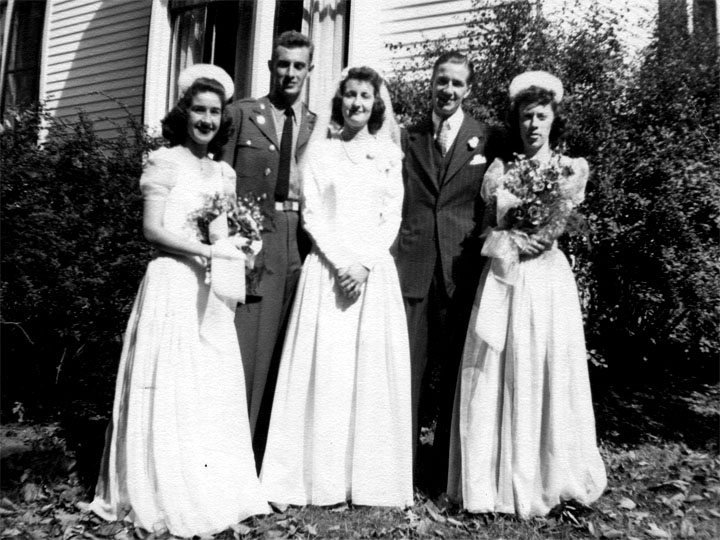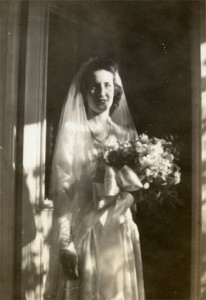While writing NEXT OF KIN, my youngest sister, Frances gave me copies of certificates from my mother’s cedar chest, witnesses to her relationship with Carl Robert Swanson.
1. Marriage certificate, #218493.“This copy for the bride”. On it I find the date Marcelle A. Prudell must have marked silently all her life, September 25th, 1943, two days after her 24th birthday. The certificate was issued on September 24th for a marriage that took place in Wood, in the county of Milwaukee on September 25th; Charles Prudell and Cecile Bemis were witnesses;
Carl was 22 years old and had lived at 1306 S. 75th Street in West Allis, Wisconsin. His father was Robert C. Swanson and his mother Meta Glocke. Marcelle A. Prudell resided at Wood, Wisconsin and was 24 years old; it was the first marriage for each of them. Marcelle was a ‘clerk’ and Carl was simply in ‘U.S. Army’. Joseph Prudell was the father of the bride, and Marie Klein, the mother. There is a signature of a Rev, the person officiating at the marriage, but I can’t make out the name.
2. War Department Report of Change of Status and address. At the time of their marriage, Private First Class Carl Robert was stationed at Fort Miles, Delaware. His Army serial number was #36266015. His mother lived at 1306 S. 75th Street, West Allis, Wisconsin.
3. Last Will and Testament of Carl R. Swanson. I learn that he is a legal resident of Wood, Wisconsin. (Did he live at my mother’s family home during his leave from active duty?) The will is signed at Fort Georgia, Maryland on the 6th of September, 1944. It is witnessed by three people whose addresses are: Cumblerland, Maryland; Cleveland, Ohio and Seabord, North Carolina. Perhaps their unit learned they were being shipped out to Europe and Carl decided to get his affairs together. At this date, he and Marcelle had been married — just two weeks less than a year. In his will, Carl Robert leaves Marcelle “all my estate and all of the property to which I may be entitled at the time of my decease.” He also names Marcelle executrix of his will, which means that she could have his estate without any any need for an official bond.*
4. Letter from HEADQUARTERS 180th INFANTRY, Office of the Regimental Commander, APO 45, % Postmaster, New York, N.Y.
27th February 1945
Mrs. Marcelle A. Swanson
Woods, Wisconsin.
My dear Mrs. Swanson:
By the time you receive this letter the War Department will have informed you of the very regrettable death of your husband, Carl R. Swanson, 36266015. He was killed in action in Alsace, France.
I realize there is little that I may say by way of condolence that will lift the burden of sorrow which much lie heavily upon your heart. It should, however, be a comforting thought to conemtplate that your husband gave his life on the field of battle. He died that those back home might have a better and a safer world in which to live.
He is buried in a well cared for American Cemetery in Eastern France, where a Chaplain of his faith conducted services at his grave.
The loss of your husband has been felt keenly in this regiment, as he was an excellent soldier and was admired by all who knew him.
I can only assure that I, and the men of my command, will dedicate our every effort to achieve ultimate victory, so that your husband’s death may not have been without a solemn purpose.
May God’s Divine Guidance be with you in this time of tribulation.
With deepest sympathy,
EVERETT W. DUVALL, Lt. Col, 180th Infantry, Commanding
5. From War Department in Washington, D.C., dated 2 March 1945
In reply, refer to:
AG 201 Swanson, Carl R. PC-N ET0055
To: Mrs. Marcelle A Swanson, Woods, Wisconsin
“It is with profound regert that I confirm the recent telegram informing you of the death of your husband, Private First Class Carl R. Swanson, 36266015, Infantry, who was previously reported missing in action on 8 January 1945 in France.
“An official message has now been received which states that he was killed in action on the date he was previously reported missing in action . . .
“I realize the burden of anxiety that has been yours since he was first reported missing in action and deeply regret the sorrow this later report brings you. May the knowledge that he made the supreme sacrifice for his home and country be a source of sustaining comfort.
My sympathy is with you in this time of great sorrow.
Sincerely yours,
J.A. ULIO, Major General/The Adjutant General”
6. Newspaper clippings. “Local names in War Toll” headlined “Relatives Are Notified” and “The following casualties have been reported by the armed forces or by relatives:” Carl Robert’s skinny-boy-face is lined up with five others. Here I learn that Marcelle, at the time of Carl’s death, was in the WAVES in New York City, that Carl Robert had attended Marquette University, that he want to Pio Nono High School, was employed by Allis Chalmers and entered the service a year before his marriage to Marcelle, in September of 1942. The 2nd article from The Citizen, announces a requiem mass held for him at Holy Assumption church.
The third article, entitled: “Entire 19th Army of Foe Smashed During Fighting in Colmar Pocket” with the sub head: “Six of Eight Divisions Completely Elminiated — Enemy Losses Are Expected to Reach 26, 000 Men – Strasbourg Threat Ends
by Richard H. H. Johnston
by Wireless to The New York Times
“WITH SIXTH ARMY GROUP in France, Feb. 10- An official recapitulation of the results of the collapse of the Colmar pocket after a twenty-one-day assault by American and French forces under the command of Lieut. Gen. Jacob L. Devers revealed tonight that the entire German Nineteenth Army, “has been eliminated as an effective force.” The article recpas the activity of these forces from December to Feb 5th. Notably:
“At the time of the enemy’s New Year’s Day offensive against the American Seventh Army, 60,000 troops; of whom 17,000 were combat effective, held the sallient. It was against this strength, composed of about eight divisions, that th attack on the Colmar pocket was launched.
“On January 6th and 7th, the enemy attacked northward out of the pocket simultaneously with the attack southward from Gambsheim in an effort to pinch out Heinrich Himmler’s promise of Strasbourg as a thirteenth anniversary present of the Nazi Government to the German people. The attacks failed.”
In my yellow Michelin map, Colmar is due east of Epinal, just outside the French border, about 85 kilometres away.
7. Letter from the War Department . On October 8, 1946, nine months after my mother and father were married, (Mother was 5 months pregnant with Gregory), this letter informs Mrs. Marcelle A. Swanson of the name of the cemetery where Carl R. Swanson was buried.
“The War Department is most desirous that you be furnished information regarding the buiral location of your husband, the late Private First Class Carl R. Swanson, A.S.N. 36-266-015.
“The record of this office disclose that his remains are interred in the U.S. Military Cemetery Epinal, plot 2-N, row 6, grave 5682. You may be assured that the identification and interment have been accomplished with fitting dignity and solemnity.
“This cemetery is located two and one-half miles south of Epinal, France and is under the constant care and supervision of United States military personnel.has now been authorized to comply, at Government expense, with the feasible wishes of the next of kin regrading final interment, here or abroad, of the remains of your loved one. At a later date, this office will, without any action on your part, provide the next of kin with full information and solicit his detailed desires.
Please accept my sincere sympathy in your great loss.
Sincerely yours,
T.B. LARKIN, Major General, The Quartermaster General”
8. Temporary Resting Place, Epinal. On my father’s birthday in 1947, April 14, a year and three months after my parents were married and living in Detroit, Michigan and almost three months after their first child, Gregory, was born, another letter was addressed to Mrs. Marcelle A. Swanson of Woods, Wisconsin was written from The War Department.
“Dear Mrs. Swanson, Inclosed herewith is a picture of the United States Military Cemetery Epinal, France, in which your husband, the late Private First Class Carl R. Swanson, is buried.
“It is my sincere hope that you may gain some solace from this view of the surroundings in which your loved one rests. As you can see, this is a place of simple dignity, neat and well cared for. Here, assured of continuous care, now rest the remains of a few of those heroic dead who fell together in the service of our country.
“This cemetery will be maintained as a temporary resting place until, in accordance with the wishes of the next of kin, all remains are either placed in permanent American cemeteries overseas or returned to the Homeland for final burial.
Sincerely yours.
G.A. HORKAN, Brigadier General, QMC, Chief, Memorial Division”
9. Letter from War Department. By July 16, 1947, Mother was pregnant with Therese, her second child by my father. Two and half years had gone by since Carl was killed. Between this letter and the Headstone Inscription and Interment Record which was photocopied for me at the office in Epinal, it looks like Marcelle relinquished her right as Next of Kin to make the ultimate decision where Carl Robert should be buried. The Headstone Inscription shows Meta Swanson as Next of Kin. That would explain why Mother gave me the wrong grave, plot and row number. Once she relinquished her status as Next of Kin, it was Meta who would have received notice that Carl Robert had been reburied. As the French man who spoke perfect English explained: as they fell, the 12,000 soldiers were buried in temporary graves in Epinal. After the war, loved ones were given the choice to repatriate their loved ones remains – to have them sent back to their communities for burial, or remain at Epinal. The 5,000 soldiers left at Epinal were reburied with white crosses.
*In 2004, after Next of Kin had been published in the Milwaukee Journal Sentinel under the title of A Visit for Remembrance, Mary Glocke Turner, a relative of Meta Glocke wrote telling me that the chief item in Carl’s estate left to Marcelle was a $10,000 life insurance policy. Marcelle gave that to her former mother-in-law Meta Glocke Swanson, as her husband Bob (Carl’s father) had died of pneumonia at a very young age. Meta had raised Carol and Carl on her own and Marcelle figured she could use the money. Meta hung onto the money and further bequeathed it to her daughter Carole to buy a home when she married.




